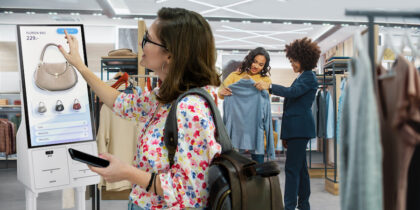Multichannel retailing is critical for the success of today’s merchants. Modern retail customers don’t make purchases solely in stores or online; instead, they tend to shop across channels, often starting research in one channel and completing their purchase in another. In moving from channel to channel, consumers expect to have a seamless customer experience.
Especially when it comes to pricier items, today’s consumers are much more shoppers than they are buyers — researching online, examining products in the store (a practice known as “showrooming”) and checking various review sites before making a final purchase decision. Retailers need to remove any friction during this customer journey to enhance the chance of a sales conversion, according to McKinsey & Company. For example, if a customer starts shopping online and supplies their name and phone number, they expect that information, as well as product specs and data on inventory and shipments, to be readily available to the sales associate at the brick-and-mortar location.
Revolutionizing Retail Through Technology
View the infographic to learn how digital technology is transforming the shopping experience. Download Now
As iPerceptions reports, optimizing customer care processes for omnichannel simplicity, such as streamlining the online ordering process by pre-populating fields with available information (such as items last viewed for a returning prospect), is one of the key capabilities of top-performing merchants.
Proper Technology Triggers Sales
In order to support this seamless customer experience, retailers need technologies that will deliver consistent information to customers, regardless of channel. On-site sales associates can use tablets in-store in order to access up-to-date customer and product information that mirrors what can be found online. Tablets also provide workers with enhanced mobility — instead of going to the back to check if an item is in stock, they can pull this information up on their tablets from anywhere in the store. Customers can also use tablets to access store apps and see right away if a retailer has an item in their size. However, when using tablets, data security is essential; retailers must be able to lock down tablets to ensure data is only accessible to authorized personnel.
Merchants should also be able to capture customer information and store it in such a way that it can populate ordering systems. E-commerce should recognize any sales touch points that have already occurred in the physical store, such as sign-ups for loyalty programs, which provide data to automatically populate fields for online or mobile orders, or any actual sales to facilitate follow-up communications with customer service.
To enable merchants to take full advantage of seamless integration, stores need to have integrated and mobile point-of-sale (POS) systems that use open source technology. Just as they want channel choice and a consistent multichannel experience, customers also want a choice in their payment methods, which increasingly include mobile payment options like Samsung Pay, a capability that retailers can offer with most existing POS devices that use magnetic stripe, NFC or EMV card reader technologies. It should be noted that in order to mitigate their liability for fraudulent charges, retailers should be using EMV-capable terminals.
Multichannel retailing must be approached as a universal system, not as a collection of silos. Consumers don’t see the channels differently, and retailers shouldn’t either. That means that a merchant’s multichannel retailing technologies and company resources should all be designed to recognize and optimize the universal, rather than channel-specific, nature of today’s retail environment.
Samsung Galaxy tablets can provide a mobile point-of-sale system that empowers sales associates to provide a more consumer-driven experience. Learn how mPOS can increase customer retention here.








